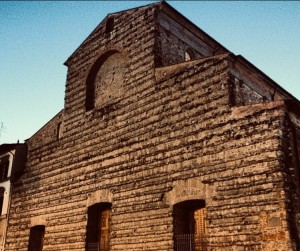La chiesa paleocristiana fu fondata verso la fine del IV sec. d.C. all’estremo opposto della Basilica di San Lorenzo, presso il borgo esistente oltre il fiume Arno: i due poli del cristianesimo fiorentino, costruiti in zone opposte, entrambi fuori le mura che delimitavano la città pagana.
Gli scavi eseguiti negli anni ’40 del XX secolo hanno portato alla luce resti di una basilica cimiteriale paleocristiana, sostanzialmente coeva a S.Lorenzo, fine IV- inizi V sec. L’area presentava tombe monumentali, come spesso accadeva in aree di forte transito appena fuori dalle porte della città. La basilica era a tre navate, larga 26 metri e lunga circa 38 e all’interno della chiesa insisteva l’area cimiteriale per la comunità cristiana che ha restituito interessanti epigrafi funerarie. Nel sottosuolo esistono una serie di cunicoli, dai quali è possibile vedere anche un tratto dei resti della Via Cassia romana, alcuni metri sotto il livello del suolo odierno.
Nella vicina Piazza dei Rossi fu rinvenuto un tratto del lato della basilica con caratteristiche costruttive del tutto simili a quelle della facciata. Le numerose epigrafi rinvenute, ora esposte nell’androne a destra della Chiesa, hanno datazioni comprese tra i primi anni del V e la metà del VI secolo d.C. , e hanno permesso di scoprire che la basilica era al centro della vita spirituale di una comunità composta anche da un gruppo di origine siriana, probabilmente commercianti pervenuti via mare, approdando alla foce dell’Arno, oppure arrivati da Roma attraverso la via Cassia Adrianea.
Con la definitiva decadenza dell’impero romano le costruzioni fuori mura, come questa, rimasero facili vittime degli assedi e delle devastazioni di Goti e Longobardi che finirono col prendere possesso di Firenze. A queste vicende, molto probabilmente, si deve la distruzione della basilica paleocristiana.
La costruzione della nuova chiesa avvenne nell’XI secolo. Al 1055 con il Concilio di Firenze si ebbe la prima menzione documentaria di un annesso monastero di monache benedettine. Il 7 novembre 1057 Papa Niccolò II consacrò la nuova chiesa e il nuovo monastero. Di questa chiesa, di epoca e stile romanici, oggi restano solo pochi ma notevoli resti incorporati nelle case e nei locali di servizio in piazza Santa Felicita. L’aspetto odierno risale al XVIII secolo.
——————————
The early Christian church was founded towards the end of the 4th century. A.D. at the opposite end of the Basilica of San Lorenzo, in the village existing beyond the Arno river: the two poles of Florentine Christianity, built in opposite areas, both outside the walls that delimited the pagan city.
The excavations carried out in the 1940s have brought to light the remains of an early Christian cemetery basilica, substantially coeval with S. Lorenzo, late 4th-early 5th century. The area had monumental tombs, as it often happened in areas of high transit just outside the city gates. The basilica had three naves, 26 meters wide and about 38 long and inside the church there was the cemetery area for the Christian community which brought to light interesting funerary epigraphs. In the subsoil there are a series of tunnels, from which it is also possible to see a stretch of the remains of the Roman Via Cassia, a few meters below today’s ground level.
In the nearby Piazza dei Rossi, a section of the side of the basilica was found with construction characteristics very similar to those of the facade. The numerous epigraphs found, now on display in the entrance hall to the right of the church, date from the early fifth to the mid-sixth century AD. , and made it possible to discover that the basilica was at the center of the spiritual life of a community also made up of a group of Syrian origin, probably merchants who arrived by sea, landing at the mouth of the Arno, or who arrived from Rome via Cassia Adrianea.
With the definitive decline of the Roman Empire, buildings outside the walls, like this one, remained easy victims of the sieges and devastations of Goths and Lombards who ended up taking possession of Florence. These events are most likely due to the destruction of the early Christian basilica.
The construction of the new church took place in the 11th century. In 1055 with the Council of Florence the first documentary mention was made of an annexed monastery of Benedictine nuns. On 7 November 1057 Pope Nicholas II consecrated the new church and the new monastery. Of this church, of Romanesque epoch and style, today only a few but remarkable remains remain incorporated in the houses and in the service rooms in Piazza Santa Felicita. Today’s appearance dates back to the 18th century.
www.facebook.com/adayinflorence
www.instagram.com/adayinflorence




